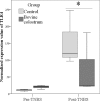Preventive effects of bovine colostrum supplementation in TNBS-induced colitis in mice
- PMID: 30138385
- PMCID: PMC6107273
- DOI: 10.1371/journal.pone.0202929
Preventive effects of bovine colostrum supplementation in TNBS-induced colitis in mice
Abstract
Inflammatory bowel disease (IBD) is a chronic inflammatory disorder for which the current medical therapy is not completely effective. Bovine colostrum (BC) is a biological fluid rich in bioactive molecules that may have beneficial effects on several gastrointestinal disorders. The objectives of this study were to assess the preventive effects of BC supplementation in a mouse model of 2,4,6 trinitrobenzene sulfonic acid (TNBS)-induced colitis using a multidisciplinary approach. Specifically, the following parameters were evaluated: (i) disease activity index (DAI), (ii) histological score, (iii) expression levels of TLR4, anti- and pro-inflammatory cytokines, and (iv) count of some bacterial species of the intestinal microbiota. Mice received a daily suspension of BC (BC group, n = 12) or saline solution (control, CN group, n = 12) for 21 days before the intrarectal inoculation with 1% of TNBS solution. BC was well tolerated and did not induce any histological damage or clinical symptoms. After TNBS treatment, BC group showed a reduction of body weight (BW) loss (P<0.01) and histological score (P<0.05) compared to CN. Moreover, the expression levels of TLR4 (P<0.05), IL-1β (P<0.001), IL-8 (P<0.001), and IL-10 (P<0.001) were lower in mice administered with BC, while the concentrations of TNF-α did not show any differences between groups. Finally, the supplementation with BC resulted in a differential response to TNBS treatment in the bacterial count. In CN group, E. coli and Enterococci increased (P<0.001), while Anaerobes (P<0.01), Lactobacilli, and Bifidobacteria (P<0.001) reduced. Conversely, no significant changes in bacterial load were found after the inoculation of TNBS in BC pre-treated mice. This study confirms that TNBS-induced colitis model in mice is useful for studying the mechanisms involved in IBD pathogenesis and shows that pre-treatment with BC reduces the intestinal damages and clinical signs of the colitis. Molecular mechanisms and intestinal microflora could be involved in the protective effect of colostrum.
Conflict of interest statement
The authors have declared that no competing interests exist.
Figures





References
-
- Sands BE. From symptom to diagnosis: Clinical distinctions among various forms of intestinal inflammation. Gastroenterology. 2004;126(6):1518–32. - PubMed
MeSH terms
Substances
LinkOut - more resources
Full Text Sources
Other Literature Sources

